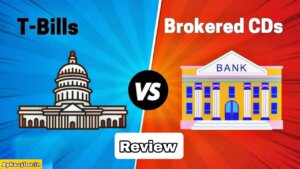
When it comes to growing your savings without taking on too much risk, two popular options often come to mind: Certificates of Deposit (CDs) and Treasury Bills (T-Bills). Both are relatively low-risk investment vehicles that offer predictable returns and are commonly used by conservative investors looking to preserve capital while earning some interest.
But how do these two options stack up in terms of returns, safety, liquidity, tax efficiency, and overall suitability for different types of savers? In this comprehensive comparison, we’ll explore how CDs and T-bills work, highlight their pros and cons, and help you decide which might be better for maximizing your savings in today’s financial environment.
- Kotak Neo: A Complete Guide
- INDmoney: A Deep Dive into India’s All-in-One Financial Super App
- Supermoney Upi App Reward
- CoinDCX: India’s Leading Crypto Exchange
1. Understanding the Basics
What Are CDs?
Certificates of Deposit are time-bound savings products offered by banks and credit unions. When you open a CD, you agree to deposit a certain amount of money for a fixed period—ranging from a few months to several years—in exchange for a guaranteed interest rate. The key characteristic of a CD is that you cannot access the funds without penalty until the term ends (also known as the maturity date).
-
Issuer: Banks and credit unions
-
Interest: Fixed rate
-
Term: Typically 3 months to 5 years
-
Penalty: Early withdrawal usually results in a fee or loss of interest
What Are Treasury Bills?
Treasury Bills (T-Bills) are short-term debt securities issued by the government—most notably, the U.S. Department of the Treasury. They are sold at a discount and mature at face value, with the difference representing the investor’s return. Unlike CDs, T-bills do not pay periodic interest (no coupons); instead, the return is realized at maturity.
-
Issuer: National government (e.g., U.S. Treasury)
-
Interest: No periodic interest; sold at a discount
-
Term: Typically 4, 13, 26, or 52 weeks
-
Penalty: None if held to maturity; can be sold early in secondary markets
2. Safety and Risk
CD Safety
CDs are considered extremely safe, especially those issued by FDIC-insured banks (or NCUA-insured credit unions). In the United States, the Federal Deposit Insurance Corporation (FDIC) insures up to $250,000 per depositor, per institution, providing peace of mind even during uncertain economic times.
T-Bill Safety
T-bills are backed by the full faith and credit of the U.S. government (or other sovereign governments), making them among the safest financial instruments in the world. The risk of default is essentially nonexistent unless the government itself faces financial instability.
Verdict on Safety
Both CDs and T-bills are extremely safe. However, for ultra-conservative savers, T-bills have a slight edge, as they’re backed by sovereign governments rather than private institutions—even if those institutions are insured.
3. Liquidity and Access to Funds
CD Liquidity
CDs lock in your money for the duration of the term. If you need to withdraw early, you’ll usually face a penalty, which could range from a few months’ interest to more, depending on the bank’s terms. Some banks offer “no-penalty CDs”, but these typically come with lower interest rates.
T-Bill Liquidity
T-bills are more liquid because they can be sold in the secondary market before they mature. While their value can fluctuate slightly based on interest rate changes, short durations help minimize market volatility.
Verdict on Liquidity
T-bills offer greater liquidity and flexibility. If you value access to your funds before maturity, T-bills may be the better choice.
4. Interest and Returns
CD Returns
CDs generally offer fixed interest rates, and rates increase with longer terms. In competitive rate environments, some banks offer high-yield CDs that can outperform other conservative investments. However, if interest rates rise after you’ve locked into a CD, you miss out on those higher rates.
T-Bill Returns
T-bill returns are determined by the discount rate at which they are sold. They are heavily influenced by the Federal Reserve’s monetary policy, and tend to move with market interest rates. While T-bills are highly secure, their returns are often slightly lower than long-term CDs during stable periods.
Sample Comparison (Hypothetical 2025 Rates)
| Product | Term | Yield (Annualized) |
|---|---|---|
| 1-Year CD | 12 months | 4.80% |
| 52-Week T-Bill | 12 months | 4.50% |
Note: These are hypothetical figures. Always check current market rates before making decisions.
Verdict on Returns
For those willing to lock in funds for longer terms, CDs may offer higher yields, especially from online banks or credit unions. However, T-bills are more responsive to short-term rate hikes, and may outperform in volatile interest rate environments.
5. Tax Considerations
CD Taxation
Interest earned on CDs is generally fully taxable at the federal, state, and local levels, depending on where you live. This could significantly reduce your real return if you’re in a high tax bracket.
T-Bill Taxation
T-bill earnings are subject to federal income tax but are exempt from state and local taxes. This tax advantage can make T-bills more attractive, particularly for residents of high-tax states like California or New York.
Tax-Adjusted Example
-
A CD yielding 4.80% in a high-tax state might net only 3.36% after all taxes.
-
A T-bill yielding 4.50% and exempt from state/local tax could result in a higher net return despite the lower nominal yield.
Verdict on Taxes
If you live in a high-tax state, T-bills are more tax-efficient, potentially boosting your effective returns over CDs.
6. Impact of Interest Rate Environment
CDs in a Rising Rate Environment
CDs are less attractive in a rising rate environment because once you lock in a rate, you’re stuck with it—even if rates go higher later. You would miss out unless you’re using short-term CDs or a CD laddering strategy.
T-Bills in a Rising Rate Environment
T-bills adjust quickly to interest rate changes because of their short durations. You can reinvest at higher rates when they mature, giving you a better way to keep up with rising rates.
CDs in a Falling Rate Environment
In a falling rate environment, CDs shine, as you’re locked into a higher rate while newer CDs and other instruments offer less. This can give you predictable, above-market returns for the duration of the CD term.
T-Bills in a Falling Rate Environment
T-bills will yield less as you reinvest at lower rates, which can make long-term CDs more appealing for income-oriented savers.
Verdict on Rate Sensitivity
-
In a rising rate environment, T-bills are better.
-
In a falling rate environment, CDs have the advantage.
7. Flexibility and Strategic Use
CDs for Long-Term Planning
CDs are best suited for savers with clear timelines and little need for early access to funds. They are great for:
-
Saving for a future down payment
-
Parking emergency funds (using no-penalty CDs)
-
Locking in income for retirees
T-Bills for Short-Term Needs
T-bills work well for:
-
Managing cash reserves
-
Temporarily holding funds for upcoming expenses
-
Building a low-risk investment ladder
Using Both Strategically
Many investors choose to combine CDs and T-bills to balance returns, liquidity, and safety. For example:
-
Short-term funds in 3-month T-bills
-
Medium-term funds in 1-year CDs
-
Long-term funds in 3–5 year CDs when rates are favorable

8. Early Withdrawal and Exit Options
CD Early Withdrawal Penalties
Banks typically charge a penalty for withdrawing from a CD before its maturity. This can range from 3 months to 12 months’ worth of interest—or more for longer terms.
Example:
If you invest $10,000 in a 2-year CD at 4.5% and withdraw after 6 months, you might lose 6–12 months of interest, effectively reducing your return below that of a standard savings account.
T-Bill Exit Flexibility
T-bills can be sold in the secondary market before maturity. While you might sell at a small loss if rates have risen, there is no penalty—making T-bills more flexible.
9. Minimum Investment Requirements
CDs
Minimum deposits vary by institution. Some CDs are available for as little as $500, while others require $1,000 or more.
T-Bills
In the U.S., T-bills can be purchased through TreasuryDirect.gov in increments as low as $100, making them highly accessible to small investors.
10. Inflation Risk
Both CDs and T-bills are vulnerable to inflation risk, meaning that if inflation is higher than your return, your real purchasing power declines.
-
A CD earning 4% when inflation is 5% = -1% real return.
-
A T-bill earning 3.8% under the same condition = -1.2% real return.
TIPS as an Alternative
If inflation protection is important, consider Treasury Inflation-Protected Securities (TIPS) instead of standard T-bills or CDs.

Conclusion: Which Is Better for Maximizing Your Savings?
There is no one-size-fits-all answer to the question of whether CDs or T-bills are better for maximizing savings. It depends on your financial goals, tax situation, need for liquidity, and expectations for interest rates.
Choose CDs if:
-
You want guaranteed returns for a specific period.
-
You’re comfortable locking in your money.
-
You want to take advantage of high fixed rates before they fall.
-
You’re investing in tax-advantaged accounts like IRAs (where taxes are less of a concern).
Choose T-Bills if:
-
You want flexibility and access to your money sooner.
-
You live in a high-tax state and want better after-tax returns.
-
You believe interest rates are rising and want to keep pace.
-
You’re looking for a safe parking place for short-term funds.
Final Tip
Consider building a laddered portfolio of CDs and T-bills to diversify your risk and improve flexibility. For example, stagger the maturities so that you always have funds coming available every few months.